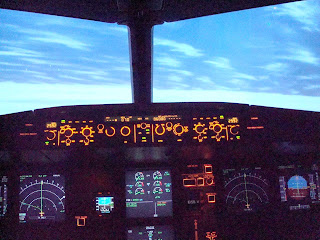CAE deserves our appreciation also as they were tireless in their efforts to make sure the sim met the expectations of the FAA Part 60 certification circular and the needs of the of FAA NSP team here to evaluate the sim.
CAE celebrated the certification by taking all the players out to dinner - and we ate well!
 A copy of the Statement of Qualification signed by many of the people involved.
A copy of the Statement of Qualification signed by many of the people involved. A very happy Denis Pelletier from CAE
A very happy Denis Pelletier from CAE Enjoying some drinks while waiting for our table.
Enjoying some drinks while waiting for our table. Anne-Elisabeth Dutil from CAE and John Sutherland from US Airways.
Anne-Elisabeth Dutil from CAE and John Sutherland from US Airways. All smiles.
All smiles. Tony Tsao from CAE just can't stop working!
Tony Tsao from CAE just can't stop working! Extra-Happy Hour.
Extra-Happy Hour. Stephane and Stephane are just tired, not drunk!
Stephane and Stephane are just tired, not drunk! Lead Sim Engineer, Dennis Newell with Phil Perey from CAE and US Airways pilot, Al Hancock.
Lead Sim Engineer, Dennis Newell with Phil Perey from CAE and US Airways pilot, Al Hancock. Appetizers and drinks.
Appetizers and drinks. Arnab (not) harrassing the restaurant manager.
Arnab (not) harrassing the restaurant manager. Here comes the meat!
Here comes the meat! A quick toast.
A quick toast. Raised glasses.
Raised glasses. Toasting success!
Toasting success!A special thanks to the folks a Fogo E Brasa restaurant for their fine food, excellent service and letting us hang around so late!



 An nice picture of the Flight Training Center Main Entrance provided by Jim Couch
An nice picture of the Flight Training Center Main Entrance provided by Jim Couch Stephane changing a loudspeaker in the visual mirror area, Safely!
Stephane changing a loudspeaker in the visual mirror area, Safely! A view of the back projection screen from the mirror side.
A view of the back projection screen from the mirror side. Tony Tsao, the CAE Project Manager, and CAE Denis Pelletier, the Program Manager preparing for the certification kick-off meeting.
Tony Tsao, the CAE Project Manager, and CAE Denis Pelletier, the Program Manager preparing for the certification kick-off meeting.
 Kick-off meeting attendees.
Kick-off meeting attendees.
 A fine lunch provided by CAE.
A fine lunch provided by CAE. Closing the day with a certification group debriefing.
Closing the day with a certification group debriefing. US Airways Sim Engineer, Dennis, CAE Test Engineer Anne-Elisabeth and US Airways Pilot, Al.
US Airways Sim Engineer, Dennis, CAE Test Engineer Anne-Elisabeth and US Airways Pilot, Al. Louardi, Al and Dennis enjoying the wait
Louardi, Al and Dennis enjoying the wait Camera mounted to ceiling of flight deck
Camera mounted to ceiling of flight deck Playback Station in pilot breifing room
Playback Station in pilot breifing room Completed work stand and cable raceways
Completed work stand and cable raceways Flying above the cloud tops
Flying above the cloud tops Test-fitting the maintenance platform
Test-fitting the maintenance platform Pilot Jon Witten from our Flight Standards department checking the instruments
Pilot Jon Witten from our Flight Standards department checking the instruments Carpet with sound-dampening pad is installed
Carpet with sound-dampening pad is installed Henry working on the Auto-Alignment camera
Henry working on the Auto-Alignment camera The view from behind tha Captains seat
The view from behind tha Captains seat The view out the F/Os front window
The view out the F/Os front window The view from the F/Os side window
The view from the F/Os side window A look at LAX from the take-off position
A look at LAX from the take-off position Close-up of shutters installed on a projector
Close-up of shutters installed on a projector Henry, the visual specialist, doing the initial geometry alignment
Henry, the visual specialist, doing the initial geometry alignment A view of the alignment grid with all colors turned on
A view of the alignment grid with all colors turned on Alignment grid showing the cursor and only one color turned on per channel
Alignment grid showing the cursor and only one color turned on per channel Cabinets all closed up except the front door of the Image Generator complex
Cabinets all closed up except the front door of the Image Generator complex Visual projectors showing an image, but configuration is not done yet
Visual projectors showing an image, but configuration is not done yet Cockpit instruments powered up
Cockpit instruments powered up Maximum forward motion deflection
Maximum forward motion deflection Clearance between sim and front wall at max forward deflection
Clearance between sim and front wall at max forward deflection Maximum aft motion deflection
Maximum aft motion deflection Clearance to raised accessway at max aft deflection
Clearance to raised accessway at max aft deflection Max starboard/aft deflection
Max starboard/aft deflection


